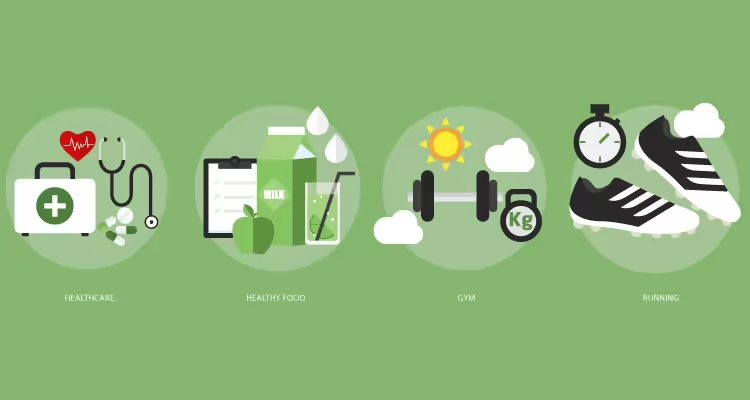Employee wellness programs generally include any health promotion intervention, or activity in the workplace designed to improve health outcomes of workers (Lee et al., 2010). Employers usually offer incentives to encourage workers to participate. Recent survey findings suggest that close to 73% of employers use some type of incentives to engage employees in wellness improvement programs (Miller, 2012).
Common examples of employee wellness programs include educational endeavours such as newsletters, seminars, health coaching, health screenings, health-related fairs and/or on-site fitness facilities. (Lee et al., 2010).
Employee wellness program benefits
The elements of employee wellness programs can vary from company to company, but the expected benefits remain similar, ranging from decreased health care costs to reduced absenteeism and turnover or enhanced productivity and company image (Baicker et al., 2010; Lee et al., 2010).
Even though each wellness program has its unique initiatives, the most common components revolve around medical screenings or surveys, wellness education programs, and exercise programs. Medical screenings are usually aimed at locating any serious health conditions and coaching employees toward improvement.
Wellness education programs can provide employees with information and knowledge about a healthy lifestyle for example dietary, fitness, stress reduction. Exercise programs focus upon getting employees active; this is commonly done by providing an on-site fitness center, or access to one, allowing employees to exercise and stretch within a convenient location.
The benefits provided by company-sponsored employee wellness programs can be attitudinal and behavioural. Zevo Health's employee wellness program can change the way people feel about their work environment (attitudinal) and also change the way people perform their work (behavioral).
Employee Morale
One way to improve morale is to show employees that the company cares about their best interests. This may increase employee morale (O’Reilly, 2006). Employee wellness programs consequently provide an opportunity for morale enhancement by having groups of employees set health goals and work with each other to achieve those goals. Demonstrating a commitment to employee wholeness, the company should offer comprehensive support, including getting legal assistance for car accidents, especially for those using company vehicles. This ensures employees can focus on recovery without the added stress of legal complexities. Another effective way to enhance morale is through fun and engaging Friday games that not only boost team spirit but also help employees unwind and connect after a busy week.
Commitment to the Organization
One commitment that a company can make to its employees is to improve and maintain their wellness. This will result in employees constantly performing at their best. According to Dyck & Neubert (2008), employees who are committed to their organizations exert more effort, go to greater lengths to help coworkers, and offer more creative ideas for organizational improvement.
Employee Productivity
Healthier employees are better equipped to combat fatigue and handle the day-to-day stresses caused by the typical work environment (Isaacson, 2010). With a greater ability to handle stress and fatigue along with being physically healthier, employees can be more productive by being able to work efficiently and consistently through the entire workday. Increased worker productivity is an associated benefit of wellness programs often sought by employers (Lee et al., 2010).
Employee Absenteeism
According to Miller (2010), healthy employees tend to miss fewer days from work due to illness, which is highly valued by employers. Another related outcome is that employees who condition themselves to make healthy life decisions may try to get family members involved in the same practices. As such, healthier employees may miss fewer days from work having to care for sick relatives.
Employee Turnover
Turnover is expensive and is often a result of a company that fails to meet the needs of its employees. With health being one of the more critical needs of employees, having a wellness program may have a positive impact on employee retention. It could also be harder for employees to leave when they are committed to an employer who has invested in their overall well-being; indeed, increased commitment leads to lower turnover (Dyck & Neubert, 2008).
Enhanced Company Image
Most of what creates the image of a company is how much it cares about and treat its employees. The support of wellness programs is one way that a company can send a message that it cares about its employees, thus enhancing its image (Lee et al., 2010). That is, if employees are happy to work for a certain company then this sends a positive message to the public, thus enhancing the company’s representation in the prospective applicant pool and community at large.
There should be a clear strategy for investing in wellness, including clearly-defined objectives, which is consistent with the overall strategy and values of the organisation. It should also be based on a clear and thorough understanding of the health and wellness profile of a particular organization.
Employers carry the role of investigating the health needs of their employees and developing interventions and initiatives. These aim to maximize the impact both on employees' well-being and also on the companies' healthcare costs, productivity and long-term value of human capital.
Data analytics and actuarial modelling can be powerful tools in providing a clear and more complete picture of the direct and indirect health-related costs, and current and future risks, to which an organization is exposed. This can assist in identifying sources of total costs, drivers of cost increases and particular issues to be targeted.

